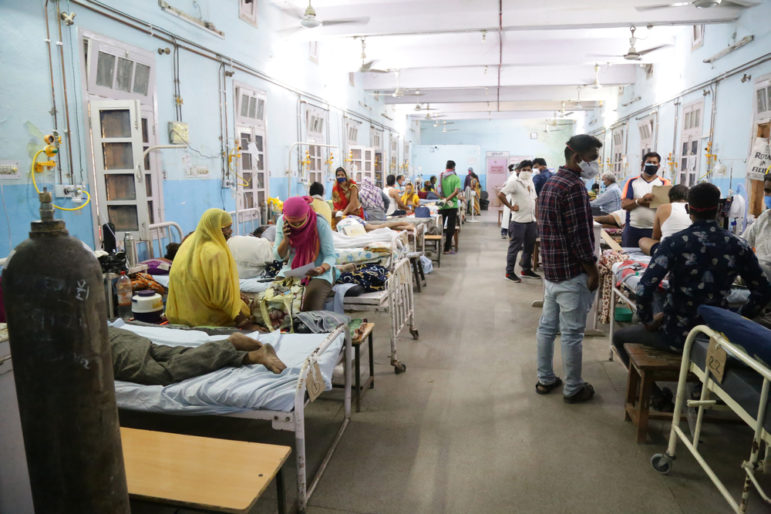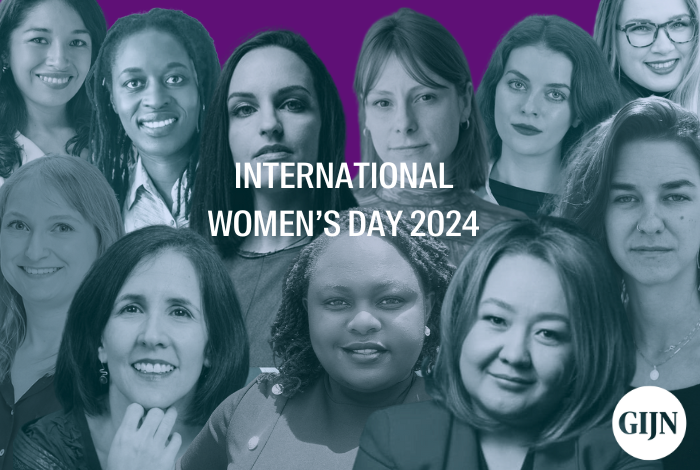

The Story of India’s COVID-19 Pandemic, as Told by Its Women Journalists
Read this article in

Patients receive treatment in a COVID-19 ward at a government hospital in Rajasthan, India, amid shortages of oxygen and beds due to surge in COVID-19 cases. Image: Shutterstock, Sumit Saraswat
Journalist Dichen Ongmu left her home in India’s northeastern province of Sikkim to avoid infecting her sister’s newborn, cut off her long hair so she could more effectively disinfect herself every night, and returned the government’s COVID-19 incentive because she believed that some of her colleagues had pocketed it undeservedly.
Another journalist in the capital Delhi filed her story despite the shock of having to say an online last goodbye to her beloved grandmother, whose health had suddenly worsened. Her family knew she would not abandon her work, even though she would have longed to be with her grandmother in her last moments.
From May to July this year, as India’s deadly second wave of the coronavirus ebbed, 40 women journalists from 30 states across India held online sessions where they recounted their experiences reporting the pandemic, revealing an extraordinarily high degree of professional ethics and commitment. Many risked infection as they went into poorly equipped hospitals to tell stories of families whose loved ones were gasping for breath, or ventured into villages to find people dying from ignorance or lack of doctors or transport. Others faced abuse and threats at crematoria where they went to count bodies.
Some went beyond their professional duty, using their privilege to resolve SOS calls during the second wave. Nights were spent coordinating with bureaucrats and hospitals, and then lying awake overwhelmed with guilt for not having been able to resolve all the distress calls they’d received.
When Gather Sisters, a Delhi-based feminist group, embarked on this project, called “The Moment, As She Knows It” — an oral history of COVID-19 as seen by India’s women journalists — many logged in only to listen to a known byline. Soon, they were logging in every weekday at 7 p.m., unwilling to miss out on the gripping stories they had come to expect.

Indian journalists discuss their pandemic experiences on the Gather Sisters project. Image: Screenshot
The primary focus was the pandemic, but, thanks to questions from Gather Sisters’ organizer Tithiya Sharma and the audience, the hour-long narrations ended up including all women’s issues in their states. Which meant literally everything.
It became clear these young journalists were already looking at events from a woman’s point of view. The neglect of social healthcare workers who were on the frontline of handling the pandemic ran like a thread through their narratives.
The Tribune’s Ruchika M. Khanna from the Punjab region bordering Pakistan described the double burden the pandemic and lockdown had imposed on women: not just looking after the household, but also dealing with a suddenly unemployed husband. She also spoke of how the ongoing farmers’ protests had left women in charge of the family and the fields back home.
For Jyoti Yadav of The Print, a publication that focuses on news and analysis, the defining story of the pandemic was the pregnant migrant laborer whose husband wanted to return home — and never mind if his wife delivered en route. Yadav made sure the woman gave birth at a hospital, but when she ran out to inform the husband that mother and child were healthy, he burst into tears on hearing it was a girl — their fifth.
Quratulain Rehbar, a freelance journalist from Kashmir, described how the pandemic had only worsened the condition of women in an area already under a military lockdown since August 2019, when Article 370, the constitutional provision that gave the state a special status, was repealed. In the absence of public transport, she said, women had to walk miles to reach hospitals, afraid to take a ride from passing vehicles. Going to the nearest police station in Kashmir was a risky affair and the changing political situation — including the dismantling of the state’s women’s commission — meant there was no local recourse left for women trapped at home facing domestic violence.
Barely 10 years into the profession, many of the reporters who told their stories during the online interactions had already covered the most marginalized communities. Krithika Srinivasan of the New Indian Express, for instance, narrated the difficulties faced by Tamil Nadu’s tribal girls in entering college. Freelancer Chhandosree Thakur from Jharkhand, a state in the east of the country, used the dialogue to talk about “witch huntings,” and gave the slogan Hum sab daayan hain (“We are all witches”) while explaining that the killing of such women is always because men covet the land they own.
Chhattisgarh tribal reporter Pushpa Rokde, of the newspaper Prakhar Samachar, laid bare the continuing brutalities committed by security forces against tribal people in the district of Bastar, and the open contempt by which tribal women are treated by non-tribal officers.
In Bihar, a completely different world was revealed by two senior journalists who explained how adolescent girls were married off overnight to strangers who would later sell them into prostitution, and how young men were abducted and forced into marriage to avoid paying a dowry. “A Bihari’s life is the cheapest,” they said, bitterly.
Fighting to be Heard
Other reporters used the dialogue to discuss the challenges they’d faced reporting from various parts of India, even before the pandemic.
Not being taken seriously by male bureaucrats and politicians was a professional hazard. “Don’t bother me with silly questions” and “you won’t understand, let it be” were among some of the responses the female reporters had received from officials. The Indian Express’s Iram Siddique, who chose to leave her comfortable job as a reporter in her own city of Mumbai and become a special correspondent in Madhya Pradesh, a state she knew nothing about, was asked how old she was by a senior politician and mocked by him for her lack of knowledge of the state.
Deepthi Bathini and the Print’s Rishika Sadam from Andhra Pradesh recounted how difficult it was to get heard as the only women in press conferences. While Jyoti Yadav had been heckled by young migrant laborers in Bihar, Bathini had plastic water pouches thrown on her while covering political rallies.
Despite all this, just how privileged young women journalists in big cities are was brought home by the journalists from Bihar. Not only did the latter have to balance home and office lives, they also had to struggle with unsafe public transport. Their male colleagues also suggested that they translate their reports, while resenting their presence in the office late in the evening (“we were expected to be at home at that time,” one said). This meant tremendous pressure to prove themselves capable of political and investigative reporting.
These journalists met the challenge, though at great cost to their mental health, said Rajni Shankar from United News of India, a news agency. Jyoti Yadav overcame an even bigger hurdle when she returned to Haryana as a jeans-clad, mobile-carrying journalist to interview the very people who’d forbidden jeans and mobiles for girls.
Interestingly, a regular listener of the series was veteran human rights defender Tahira Abdullah from Islamabad. Far from finding the accounts difficult to identify with, she “felt right at home because it was sadly all so familiar — the patriarchal attitudes, the sexual harassment, engendering a sense of sisterhood across borders.”
When Gather Sisters conceived of this series, the second wave in India was at its peak. Certain that citizens were being lied to, and that there would be no accountability, the group decided to hear the truth from eyewitness accounts of people they could trust. Given their network, it wasn’t difficult to find a diverse mix of reporters, the only criteria being that they be “newshounds” with the “insight and courage to counter the official narrative.” None of them were paid.
The series, said organizer Tithiya Sharma, left her feeling that “it’s a dangerous time to be a woman reporter.”
This story was first published on Newslaundry. It has been edited and is republished here with permission. Read the original piece here and support Newslaundry’s ad-free, independent journalism here.
Additional Resources
GIJN Guide: Resources for Women Journalists
How a Rural Women’s Paper Became a Muckraking Phenomenon in India
How Local Reporters in India Exposed the Pandemic’s True Death Toll
 Jyoti Punwani is a freelance journalist based in Mumbai whose reports and analyses have been published in national newspapers and news websites including The Times of India, The Indian Express, The Hindu, Deccan Herald, Rediff.com, Scroll, and Article 14. She writes on issues related to communalism, human rights, and the media.
Jyoti Punwani is a freelance journalist based in Mumbai whose reports and analyses have been published in national newspapers and news websites including The Times of India, The Indian Express, The Hindu, Deccan Herald, Rediff.com, Scroll, and Article 14. She writes on issues related to communalism, human rights, and the media.









